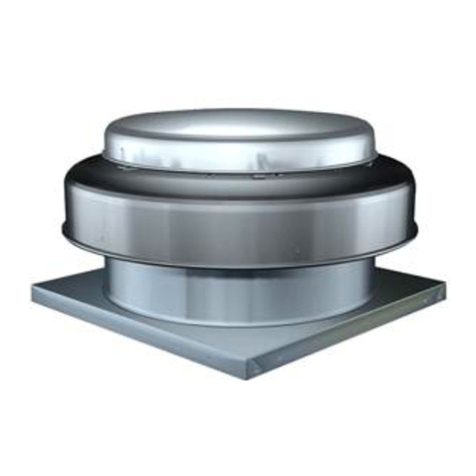
Utility Fans 3
Locate parts far enough apart to permit air circulation,
sunlight and space for periodic inspection. To
minimize water accumulation, place all fan parts on
blocking supports so rain water will run off.
Do not cover parts with plastic film or tarps as these
cause condensation of moisture from the air passing
through heating and cooling cycles.
Fan wheels should be blocked to prevent spinning
caused by strong winds.
Inspection and Maintenance During
Storage
While in storage, inspect fans once per month. Keep a
record of inspection and maintenance performed.
If moisture or dirt accumulations are found on parts,
the source should be located and eliminated. At
each inspection, rotate the wheel by hand ten to
fifteen revolutions to distribute lubricant in motor and
bearings. If paint deterioration begins, consideration
should be given to touch-up or repainting. Fans with
special coatings may require special techniques for
touch-up or repair.
Machined parts coated with rust preventive should be
restored to good condition promptly if signs of rust
occur. Immediately remove the original rust preventive
coating with petroleum solvent and clean with lint-
free cloths. Polish any remaining rust from surface
with crocus cloth or fine emery paper and oil. Do not
destroy the continuity of the surfaces. Thoroughly
wipe clean with Tectyl®506 (Ashland Inc.) or the
equivalent. For hard to reach internal surfaces or for
occasional use, consider using Tectyl®511M Rust
Preventive, WD-40®or the equivalent.
Removing from Storage
As fans are removed from storage to be installed
in their final location, they should be protected and
maintained in a similar fashion until the fan equipment
goes into operation.
Prior to assembly and installation of the unit and
system components, inspect the fan assembly to
make sure it is in working order.
1. Check all fasteners, set screws on the fan, wheel,
bearings, drive, motor base and accessories for
tightness.
2. Rotate the fan wheel by hand and assure no parts
are rubbing. Access to the wheel is obtained
through a bolted panel located on the side of the
fan housing.
3. Ensure proper wheel settings for radial gap and
alignment. Refer to Radial Gap, Overlap and Wheel
Alignment section on page 10.
Table of Contents
General Safety Information .................... 1
Receiving, Unpacking, Handling .............. 2
Storage .................................2-3
Inspection and Maintenance During Storage..... 3
Removing from Storage ..................... 3
General Information
Unit and System Identification Tags............ 4
Pre-Installation Information .................. 4
Electrical Disconnects ...................... 4
Moving Parts.............................. 4
Guards - Motor Cover, Weatherhood, Shaft,
Belt, Inlet or Outlet Guard .................. 4
Access Doors ............................. 4
Air Pressure and Suction .................... 4
Fans - Rigging and Lifting....................4-6
Installation
Discharge Positions ........................ 6
Ducted Inlet Installations .................... 7
Ducted Outlet Installations ................... 7
Non-Ducted Installations .................... 7
Bases (Foundation and Isolation) .............. 7
Fan Drainage Piping and Trap Detail ........... 8
Electrical Connections ....................... 8
Electrical Disconnects and Moving Parts........ 8
UL/cUL 762 Listed Fans for Restaurant Exhaust . . . 8
V-Belt Drives
V-Belt Drive Installation ..................... 9
Alignment of Pulleys and Belts................ 9
Field Coating Touch-Up Procedure for
Scratched Areas ........................... 9
Radial Gap, Overlap and Wheel Alignment
Radial Gap and Alignment .................. 10
Method for Centering Wheel ................ 10
Wheel Rotation ........................... 10
Radial Gap and Overlap Dimensions .......... 10
Unit Start-Up
Visual Inspection of Equipment .............. 11
Check .................................. 11
Additional Steps for Initial Start-Up ........... 11
Model XUEFD-100-BI - Three-phase .......... 11
Vibration ................................. 12
Routine Maintenance and Operation
Fan Operation............................ 12
Motors.................................. 12
Belt Drive Maintenance .................... 13
XUEF-100 Belt Adjustment.................. 13
Wheel and Fastener Maintenance ............ 13
Bearing Lubrication Schedule ............... 14
Variable Frequency Drive Operation ............ 14
Model XUEFD-100-BI - Variable Speed Drives . . 14
Bearing Replacement
Bearing Removal ......................... 15
Bearing Installation ........................ 15
Parts List ...............................16-18
Troubleshooting............................ 19
Maintenance Log.....................Backcover
Our Commitment.....................Backcover




























